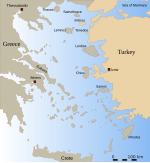Despotiko
Despotiko is situated almost exactly in the center of the Cyclades and during clear days it is possible to view the surrounding islands of Antiparos, Syros, Serifos, Sifnos, Kimolos, Folegandros, Sikinos and Ios (in anticlockwise order).
[4] These submerged archaeological structures, together with a Classical marble inscription [6] from the sanctuary on Despotiko reading ΕΣΤΙΑΣ ΙΣΘΜΙΑΣ, (Hestias Isthmias, which essentially means "for Hestia of the Isthmus"), suggest that the relative sea-level in this area was at least 3m lower during the Early Bronze Age and still more than 1m lower during the Hellenistic time.
The excavations proved the existence of an important late Archaic sanctuary with abundant objects indicating links to mainland Greece, the Eastern Mediterranean and even to Northern Africa, as well as the continued use of this area in the Classical, Hellenistic, Roman and Frankish periods.
[11] 2015 excavations at the Archaic (6th C BC) sanctuary site on an Aegean Sea islet revealed new evidence about its size and organization.
[12] Some of the artefacts from the excavations are exhibited in the archaeological museum in Parikia, the capital of the nearby island of Paros, along with other important antiquities from the region.
Due to low and non-permanent human presence, as well as moderate pasture pressure, some natural habitat types, typical of the central Cyclades, are very well preserved.
This metamorphic succession is penetrated by six early Pliocene,[21] rhyolitic volcanic pipes, with rare occurrences of small obsidian.
Patches of yellowish, porous sandstone, dominated by well rounded, well sorted fragments of marine organism and minor siliciclastic components is found in many places on top of the metamorphic rocks.

